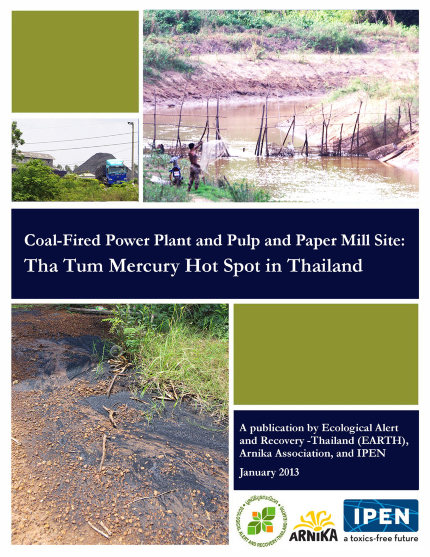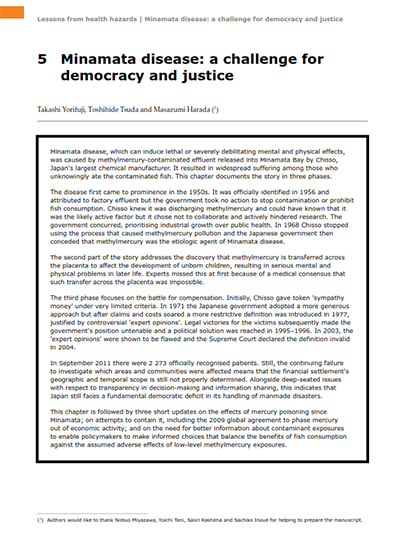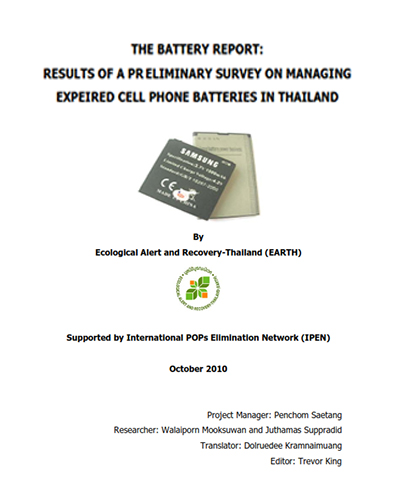Publications

Coal-fired power plant and pulp and paper mill site: Tha Tum Mercury Hot Spot in Thailand
IPEN Mercury-Free Campaign Report
Ecological Alert and Recovery - Thailand (EARTH), Arnika Association and the IPEN Heavy Metals Working Group, January 2013
This report focuses on a coal-fired power plant and pulp and paper mill in Tha Tum, Thailand, which are part of the Prachinburi Province’s largest industrial complex located 120 km to the East-North-East from Bangkok, and 5.5 km south from the Prachinburi River.

Minamata Disease: A Challenge for Democracy and Justice
Authors: Takashi Yorifuji, Toshihide Tsuda and Masazumi Harada, 2013
From European Environmental Agency Report No 1/2013 Volume II, Chapter 5, Lessons from health hazards Minamata disease: a challenge for democracy and justice.
In this chapter, the history of Minamata disease is presented chronologically, broadly separating the discussion into three parts: the period before 1968; specific issues associated with congenital Minamata disease; and the period after 1968. The chapter concludes with the lessons that can be drawn from the history of Minamata disease.

Sampling and its principles
By Jan Nezhyba, Program Toxic Substances and Waste, Arnika, 2013
This presentation describes the whole complete sampling process and how to handle the sampling plan.

Report Mercury in the Global Environment: Patterns of Global Seafood Mercury Concentrations and their Relationship with Human Health
Biodiversity Research Institute (BRI), December 2012
This report, produced by Biodiversity Research Institute (BRI), examines seafood mercury concentrations from existing reputable sources and presents collated data on different types of seafood with the goal of explaining the significance of these findings as they relate to ecological and human health. The report provides insight into the species of marine organisms with greatest concentrations of mercury. These data are then related to global seafood capture data to provide insight into the potential risks associated with consumption of marine species with high mercury concentrations.

An Overview of Epidemiological Evidence on the Effects of Methylmercury on Brain Development, and A Rationale for a Lower Definition of Tolerable Exposure
Zero Mercury Working Group, prepared by Edward Groth, December 2012
It has been well known since about 1960 that methylmercury damages the developing brain. As research has progressed and methods have improved over the years, new evidence has consistently shown that harmful effects occur at lower levels of exposure than was previously recognized. National and international government agencies have defined “tolerable exposure” limits, which are levels of intake of methylmercury believed, based on evidence available when they were set, to describe “safe” exposure, i.e., a level of intake sufficiently far below any exposure known to be harmful that it is reasonably certain to pose only a negligible risk, even to sensitive individuals and populations.

Mercury Contamination, Exposures and Risk: A New Global Picture Emerges
Zero Mercury Working group, December 2012
Mercury is a well-known and dangerous toxic pollutant that contaminates fish around the world. There has been a 3-fold increase in mercury since preindustrial times and a recent study indicates that mercury accumulation in the oceans correlates with the rising tide of mercury pollution. Mercury has no respect for national or regional boundaries. It can travel long distances through the atmosphere and deposit far from its original source, where bacteria absorb it and convert it to a very toxic form, methylmercury, which works its way up the food chain into humans.

Experiences & Understandings of the Human-Ecological Issues: Tasik Chini and Kiriwong Sites
By Penchom Saetang, Director, Ecological Alert and Recovery – Thailand (EARTH)
15 June 2012
Community Efforts in Addressing Human-Ecological Problems

Methyl Mercury Exposure at Niigata, Japan: Results of Neurological Examinations of 103 Adults
Authors: Kimio Maruyama, Takashi Yorifuji, Toshihide Tsuda, Tomoko Sekikawa, Hiroto Nakadaira, Hisashi Saito, June 2012
Large-scale poisonings caused by methyl mercury (MeHg) have occurred in Japan (Minamata in the 1950s and Niigata in the 1960s) and Iraq (in the 1970s). The current WHO neurological risk standard for adult exposure (hair level: 50 µg/g) was based partly om evidence from Niigata which did not consider any cases who were diagnosed later and/or exposed to low level of MeHg (hair mercury level less than 50 µg/g).

Industrial Pollution Impact and the PRTR Development in Thailand
By Penchom Saetang, Walaiporn Mooksuwan, Ecological Alert and Recovery – Thailand (EARTH)
29 May 2011
Explosion of the Bangkok Port’s Chemical Warehouse in March 1991: a starting point of the public demand for the right to know about the chemical information. Around 650 houses burnt down with over 5,000 slum residents, fire fighters and concerned people exposed to the toxic chemical fumes, 4 sudden death and over 100 victims proved to have chronic illness and serious health impact caused by the unknown chemical substances. The incident has important impact in Thailand’ environmental-related law reform. read more...

The Battery Report: Result of a Preliminary survey on Managing Expired Cell Phone Batteries in Thailand
By Ecological Alert and Recovery-Thailand (EARTH), Supported by International POPs Elimination Network (IPEN), October 2010
Modern humans are not only reliant but it could be argued that they are now dependent on electronic technology. In the realm of telecommunications, especially, there is continuous development of and demand for electronic products. As a result, the increased rate of electronic waste (e-waste) has grown enormously (currently estimated at 40 million tones per year by the United Nations) increase is continuing. Cell phones, in particular, will be disposed of at a rate approximately ten times higher in China and 18 times higher in India in the next ten year period.


